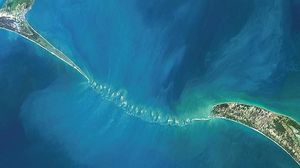Though Union Culture Minister Prahlad Singh Patel has not yet accepted the demand to declare the Ram Setu a national heritage site, he recently authorised a scientific study by organisations under his colleague, Union Health Minister Harsh Vardhan, to determine the origin of the 40km-long shoals connecting India and Sri Lanka.
Patel has moved cautiously on an issue that has divided political parties in Tamil Nadu for 16 years. He has approved a proposal from the Council of Scientific and Industrial Research and the National Institute of Oceanography to send an exploration ship to the Palk Strait to determine when the shoals, believed to be built by Ram’s army, actually originated. Many marine geologists believe this long formation is a natural one and not man-made. Proponents of the Ram Setu, however, have argued that Valmiki’s Ramayan had given detailed information on how the raging sea was bridged for a huge army to cross into Lanka to free Sita.
Shipping experts have said that the rocks were making it impossible for bigger ships to use the strait, forcing them to go around Sri Lanka, thereby increasing cost and time. A number of studies had been initiated for dredging the sea, thereby removing the shoals to develop a deep sea channel.
When the Dravida Munnetra Kazhagam joined the Manmohan Singh ministry in 2004, there was high drama over the shipping ministry. Singh, while allotting portfolios to allies, bifurcated the shipping and transport ministry, giving transport to the DMK and shipping to current Telangana Chief Minister K. Chandrashekar Rao of the Telangana Rashtra Samithi. DMK supremo M. Karunanidhi asked three of his ministers not to take charge until his party got shipping. After hurried consultations, Rao was requested to take the portfolio of labour, while shipping and transport was given to the DMK’s T.R. Baalu.
The new minister’s first priority was to launch the Sethusamudram project for dredging the Palk Strait, which led to protests by then Tamil Nadu chief minister J. Jayalalithaa, the RSS and Rajya Sabha member Subramanian Swamy. The DMK ministers pushed hard for the project, but the opponents went to court, questioning the decision on environmental and heritage grounds. The project was stalled because of the protests and was shelved later, even though a huge amount was spent on the first phase of dredging.
The BJP had declared that the Ram Setu, which also had the British name of Adam’s Bridge, would be preserved as part of heritage. Swamy has been pursuing the cause of declaring it a national monument, even asking Prime Minister Narendra Modi why the decision was being delayed.
The Union government had not moved on the issue till the Supreme Court gave its verdict on the Ayodhya land dispute in 2019. Interestingly, the Archaeological Survey of India, which has given the CSIR-NIO permission to study the shoals, had itself done marine studies to locate Dwaraka, Krishna’s lost city on the Gujarat coast. Now, the scientists would have to not only determine the age of the shoals, but also determine when the incidents in the Ramayan happened, to see whether the dates match. Meanwhile, it is election time in Tamil Nadu and the new decision will surely cause a political debate.
sachi@theweek.in


